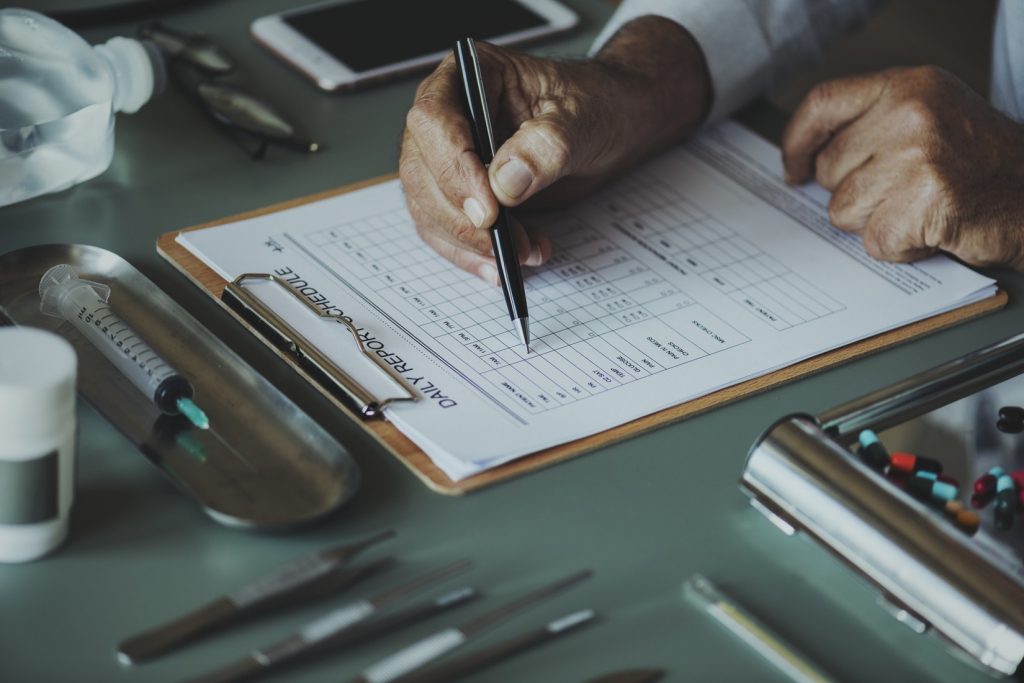Gabapentin Side Effects – Top 10 List
Gabapentin is quickly gaining a highly explosive reputation although this drug is not an opioid. In the wake of the opioid drug crisis, many news outlets have been highlighting how gabapentin distribution and use has been increasingly on the radar for both the FDA and law enforcement officials’ for it’s potentially harmful side effects and and rampant misuse. Some states, such as Kentucky and Ohio have taken some more official steps to have gabapentin listed as a controlled substance.
To highlight the risks and benfits of using gabapentin we’ve compiled a top 10 list, a comprehensive list of gabapentin side effects as well as tips for avoiding these side effects below.
Top 10 Gabapentin Side Effects
- Nystagmus
- Dizziness
- Edema
- Mood Changes
- Loss Of Memory
- Difficulty Breathing
- Weight Gain
- Depression
- Liver Problems
- Decreased or Altered Libido
1. Nystagmus

Involuntary eye movement or Nystagmus is a common short term side effect of Gabapentin.
2. Dizziness

Users of Gabapentin 100mg and other doses report a common short term side effect of dizziness, drowsiness, and generally the feeling of low energy.
3. Edema

Patients prescribed Gabapentin commonly report edema also known as retaining fluid in the legs, feet, arms or hands.
4. Mood Changes

Mood changes such as altered mental status or explosive and unprovoked anger is a less common side effect, but can cause stress with a patients family and other caregivers.
5. Loss Of Memory

A less common short term side effect of Gabapentine use include memory lapses and other forms of memory loss.
6. Difficulty Breathing

Some patients report difficulty in breathing.
7. Weight Gain

Gaining weight is a more rare, but is reported as a long term side effect.
8. Depression

Mental disorders including feelings of depression are rare, but are included as a long term side effect of Gabapentin.
9. Liver Problems

A more rare long term side effect includes the yellowing of skin or eyes from liver stress and other liver problems.
10. Decreased or Altered Libido

In rare instances patients report decrease sex drive from the long term use of Gabapentine.
Over 50 million prescriptions are written for gabapentin annually, 95 percent of which are considered “off-label.” As this widely prescribed medication is brought up in the media, the question remains, is this an effective and safe medication to be using for conditions other than what it was designed to treat? What are the side effects of using gabapentin? Should we be treating this medication like other controlled substances as we move forward?
Comprehensive List of Gabapentin Side Effects
As is normal with a lot of medications, most people notice subtle side effects when first starting or increasing the dosage of gabapentin. In most cases, when used in line with doctor instructions, side effects decrease significantly or go away altogether after awhile.
Common Short Term Side Effects
Less Common Short Term Side Effects
Common Short Term Side Effects
- Nystagmus, or involuntary eye movement
- Dizziness, Drowsiness, and general low energy
- Edema- Fluid retention in The legs, feet, arms or hands
Short term less common side effects
-
Mood Changes, such as altered mental status or explosive and unprovoked anger
- Loss Of Memory
- Difficulty Breathing
- Backache
- Blurred Vision
- Constipation
- Cough
- Diarrhea
- Double Vision
- Dry Mouth
- Dysarthria (difficult or unclear articulation of speech)
- Nausea and vomiting
- Weakness
- Hyperactivity
- Infection Caused By A Virus
- Involuntary Quivering
- Lazy Eye
- Middle Ear Infection
- Malaise
- Dry Throat
- Throat Irritation
Rare long term side effects
- Weight Gain
- Depression
- Irritability
- Giant Hives
- Decreased or Altered Libido
- Inability to focus
- Chronic Insomnia
- Enlarged Breasts
- Excessive Sweating
- Agitation
- Anxiety
- Fever
- Head Pain
- High Blood Sugar
- Erectile Dysfunction
- Increased Creatine Kinase Level
- Indigestion
- Inflammation Of The Nose
- Loss Of Appetite
- Pain
- Pink Eye
- Rash
Rare but serious side effects
- Abnormal Liver Function Tests
- Confusion
- Decreased Lung Function
- DRESS Syndrome (Drug reaction with eosinophilia and systemic symptoms)
- Erythema Multiforme (skin condition ranging from an itchy rash to mucous membrane erosions)
- Suicidal thoughts
- Hypersensitivity Drug Reaction
- Increased Eosinophils In The Blood (a disease-fighting white blood cell)
- Life Threatening Allergic Reaction
- Low Amount Of Sodium In The Blood
- Multiple Organ Failure
- Rhabdomyolysis (syndrome causing the death of muscle fibers and release into bloodstream)
- Stevens-Johnson Syndrome (rare type of severe skin reaction)
- Swollen Lymph Nodes
- Yellowing Of Skin Or Eyes From Liver Problems
If you experience any of these side effects, contact your doctor immediately. Always discuss possible side effects before taking any new medication, and discuss your medical history with your healthcare provider, so they can make the most informed and healthy choice for your optimal care.
How Can I Avoid the Negative Side Effects of Gabapentin?
Starting Medication
If you start taking gabapentin, your doctor will likely start you on a low dosage 300 mg a day. As your body adjusts to the medication, your dosage will increase. Every three to five days, the dosage will increase, up to as much as 4,800 mg/day.
Take this medication with a full glass of water. Because of the nature of the drug, this medication is taken multiple times throughout the day. No more than 12 hours should pass between doses. Consistency is important, especially in preventing seizures or epileptic episodes.
Likely you will need to take the dose three times a day. The extended-release version, (Horizant) is the exception to this rule. This tablet is taken once a day, typically at the evening meal, and should not be crushed, chewed, or cut.
When beginning to take this medication, or when you increase the dosage, it is normal to experience mild side-effects, such as drowsiness or blurred vision. For most patients, these symptoms go away within a few days. Taking the medication at night can help reduce the issues related to excessive drowsiness.
Be sure to follow all of your doctor’s instructions as you begin to take this medication. Note any reactions to the medication, and tell your doctor immediately if the symptoms become severe or persist for more than three days.
Things to Avoid While on Gabapentin
Certain substances can alter or enhance the side-effects of this medication. It has been reported to cause increased sluggishness, dizziness, and loss of coordination when combined with:
- Alcohol
- Baclofen
- Buprenorphine/naloxone
- Methadone
- Quetiapine
- Morphine (Avinza, Kadian, MSIR, others)
- Naproxen (Aleve, Anaprox, Naprosyn, others)
In most cases, people taking this medication do not need to alter their diet. Antacids, however, such as Maalox or Mylanta can decrease the effectiveness of gabapentin. They shouldn’t be taken for at least two hours prior to taking gabapentin.
If you have kidney problems, your body might process gabapentin more slowly than the average person. Especially for people of advanced age, when kidney function decreases, you should consult with your doctor before using this medication to determine if this is a safe option for you, and how to adjust the dosage.
Ending Medication
Because this medication does not have curing properties, it is imperative to continue taking gabapentin, even if you no longer feel symptoms of your condition.
Do not stop taking gabapentin without consulting medical advice first. If you are going to end treatment, make sure to follow your doctor or pharmacologist instructions carefully.
Abruptly stopping dosage can cause more extreme side effects and unwanted withdrawal symptoms, such as
- Anxiety
- Insomnia
- Nausea
- Pain
- Sweating
Slowly decreasing dosage over the course of at least a week is a much safer approach to ending this medication.
How Does Gabapentin Work?
Understanding how drugs interact with your body to alleviate pain and prevent illness is crucial. While the exact way gabapentin works is not fully understood, it increases the production of GABA, a neurotransmitter that works to calm nerves. The way it works to diminish pain is similar to how earplugs work. It doesn’t diminish the source of the “noise,” the chemicals work to dampen how much you sense the pain. It doesn’t cure chronic pain, seizures or epilepsy, but it has been proven to proactively alleviate the symptoms, when taken regularly.
Neurotransmitters are chemicals naturally found in the body that send messages between the body’s nerve cells. It is an amino acid that attaches to the calcium ion channels in your brain and spinal cord. It seems to reduce the release of glutamate, a neurotransmitter the excites the nerves in the brain. In a healthy brain, GABA and glutamate work together, exciting the nerves to send signals to the body, and calming nerve endings to reduce pain, help us fall asleep, and ultimately allowing for normal brain functioning.
Abnormal or over excited neurotransmitters can cause seizures, tremors, and pain. Gabapentin counteracts this, stabilizing the electrical energy in your brain, and reducing pain due to nerve damage, or neuropathic pain. This drug can relieve symptoms and prevent epileptic episodes, but doesn’t reverse it or heal the imbalance indefinitely. It can control pain, and keep people from having seizures, but it cannot cure the condition. For this reason, people taking gabapentin will likely need to take the medicine long term.
Gabapentin can come in a capsule, tablet, extended-release tablet, or oral solution, and is usually taken with a full glass of water. The half life of this drug is about 6 hours. In other words, it is only fully effective for a couple of hours, so most people take the medicine three or four times throughout the day.
How is Gabapentin Used?
The dosage amounts depend on an individual’s size, age, and condition.
One of the most common medications being prescribed today is gabapentin. This drug, Commonly known as Neurontin was first developed as an antiepileptic drug (AED) and is also approved by the FDA to prevent seizures and alleviate neuropathic pain. Gabapentin has been receiving more attention in the media recently, with its widespread use and increasing popularity for off-label uses.
When first on the market, Neurontin, Horizant, or another generic version of gabapentin were prescribed to patients experiencing neuropathic pain, or to control seizures. It was designed to mimic GABA (gamma-aminobutyric acid) neurotransmitters in the brain, by decreasing abnormal activity within the brain that can cause nerve pain, seizures, or tremors.
Between 1995 and 2004, gabapentin sales increased from $98 million to nearly $3 billion per year. It quickly became the top-selling anticonvulsant and ranked 17th for total expenditures among all drugs. As of September 2017, gabapentin was ranked as the seventh most commonly prescribed medication in the United States.
Neurontin, or the generic version of this drug, gabapentin is usually administered in an oral capsule. Typically, they come in 100 mg, 300 mg, and 400 mg strengths. While dosages can vary, typical dosage amounts start at 300 mg and may go up to as much as 3,600 mg per day.
For a healthy adult, dosage typically starts at 900 mg per day, (300 mg taken three times throughout the day). After a few days, dosage is gradually increased to between 2,400-3,600 mg per day.
This medication is typically refillable, without the need for a prescription every time. Your doctor will write the number of refills authorized on the prescription, and dosage will be monitored on a basis to be determined by your physician.
What Does Gabapentin Treat?
Gabapentin was first manufactured to prevent seizures. It was also approved to be an add-on treatment for patients with epilepsy in 1993. Taken two or three times a day, this medication was shown to decrease the number of seizures or epileptic episodes in patients.
In 2002, the FDA also approved the use of gabapentin to alleviate postherpetic neuralgia or PHN, the lingering nerve pain that people can experience after having shingles. Taking gabapentin can greatly diminish the stabbing pain or aches that can otherwise last for months after this painful viral infection that causes a blistering rash, often on the right side of your torso.
Who Should not take Gabapentin?
Pregnant Women
There have not been enough studies conducted on the safety of using gabapentin on pregnant women or babies in the womb. However If the expectant mother is epileptic, it can be extremely detrimental to her health, and that of her unborn baby, to suddenly stop taking gabapentin. If you are pregnant or could become pregnant and taking gabapentin, discuss the risks and your options with your primary care physician.
For nursing mothers, it is important to note that gabapentin is also passed through breast milk. As the effects of gabapentin on infants have not been studied, it is important to consult your doctor if you take gabapentin at any dosage level.
Older Adults
Some of the negative side effects of gabapentin increase with age. Studies showed that older patients taking this medication were more prone to edema, swelling of the limbs, as well as dizziness and a loss of coordination. With increased age, dizziness and loss of coordination could lead to serious injury from a fall.
As people age, renal functioning can decrease. As gabapentin is processed through the kidney, this can cause higher levels of toxicity in older patients taking this medication. While gabapentin typically has a halflife of 6 hours, for those with slower renal functioning, the drug stays in the bloodstream for longer amounts of time.
If you or a loved one is prescribed gabapentin, be sure to talk about these concerns and monitor your side effects. Lower dosage may be appropriate.
What are the Off-Label Uses of Gabapentin?
Pretty quickly after FDA approval in 1993, gabapentin became a widely used medication on the market. In 2001, the drug was the most prescribed drug for off-label uses. In fact, 95% of prescriptions written for the medication were for conditions other than the disorders it was originally designed to treat.
The increase in off-label prescriptions was attributed to the marketing and misbranding of this medication by pharmaceutical companies. A number of lawsuits were filed against these companies, including a $430 million case against Pfizer, the producer of Neurontin.
Today, doctors and psychiatrists continue to prescribe gabapentin to treat a variety of conditions that remain outside of official FDA approval, such as:
- Anxiety-related disorders including bipolar disorder, panic disorder, obsessive-compulsive disorder, phobic avoidance, and general anxiety
- Depression and irritability
- Schizophrenia and schizoaffective disorder
- Neuropathic pain, including diabetic neuropathy, Complex Regional Pain Syndrome, Trigeminal Neuralgia
- Attention Deficit Disorder
- Restless Leg Syndrome and Periodic limb movement disorder of sleep
- Chronic Migraines
- Drug and alcohol withdrawal seizures
Alicia Mack, PharmD conducted an analysis of off-label uses of gabapentin and review of medical studies, and concluded this:
“In the majority of circumstances where it has reported potential for “off-label” use, gabapentin is not the optimal treatment. The off-label use of gabapentin for indications not approved by the FDA should be reserved for cases where there is solid research support (e.g., diabetic neuropathy and prophylaxis of frequent migraine headaches). Managed care pharmacists should develop programs to restrict the use of gabapentin to these specific evidence-based situations, and key decision makers in managed care practice should feel confident in supporting these use restrictions for gabapentin…Off-label use of gabapentin should be reserved for patients who have failed standard treatment options and in those cases where randomized controlled clinical trials have demonstrated gabapentin efficacy (i.e., diabetic neuropathy and migraine headaches). Cost effectiveness ratios tend to be high (unfavorable) for the use of gabapentin in diabetic neuropathy and migraine syndrome except in those patients who experience a high frequency of acute episodes.”
Gabapentin Clinical Trials

Does Gabapentin Effectively Reduce Epileptic Episodes?
Subjects: 705 patients, ages 12 and higher, experiencing four or more partial epileptic episodes a month, in spite of receiving one or more antiepileptic medications.
Treatment: Tested the effect of gabapentin vs. a placebo added to an existing antiepilepsy therapy. Conducted across 3 multicenter, 12-week, double-blind, parallel-group trials
Results: All trials concluded that gabapentin effectively reduced partial seizures. No data was collected on the long term effects of taking this medication.
Bottom Line: As an antiepileptic drug (AED) gabapentin is seen as an effective part of treatment for those with epilepsy, and is FDA approved for this condition.
Does Gabapentin Effectively Reduce Epilepsy in Pediatric Patients?
Subjects: 247 pediatric patients (aged 3-12) with partial epilepsy
Treatment: Tested the effect of gabapentin vs. a placebo in a single, randomized double-blind, placebo-controlled, parallel group.
Results: All trials concluded that gabapentin effectively reduced partial epilepsy in children and adolescents. About 20 percent of patients reduced their epileptic episodes by 50 percent or more.
Bottom Line: As an Antiepileptic drug (AED) gabapentin is seen as an effective part of treatment for those with epilepsy, and is FDA approved for this condition.
Does Gabapentin Reduce Chronic Pain Due to Postherpetic Neuralgia?
Subjects: 563 patients with postherpetic neuralgia
Treatment: Tested the effect of gabapentin in reducing chronic pain vs. a placebo in 2 randomized double-blind, multicenter studies. Objective pain scores were measured over 7 to 8 weeks.
Results: Both studies showed a significant reduction in pain scores after just one week of using gabapentin. Approximately one in three patients noted a pain reduction by 50 percent or more.
Bottom Line: Gabapentin has shown to effectively reduce nerve pain due to postherpetic neuralgia, and is FDA approved for this condition.
Does Gabapentin Increase Suicidal Behavior?
Subjects: Meta Analysis of 199 clinical trials
Treatment: Pooled analyses of 199 placebo-controlled clinical trials, with a median treatment duration for 12 weeks.
Results: There was an estimated one case of increased suicidal behavior out of every 530 patients. There were four reported suicides in drug-treated patients during trials with patients taking antiepileptic drugs (AEDs), and zero instances of suicide in patients taking a placebo. Increased risk of suicidal thoughts and behavior were reported as quickly as one week into the drug trial. As none of the trials extended beyond 12 weeks, the long-term effects of suicidal behavior while on gabapentin could not be assessed.
Bottom Line: Any antiepileptic drug including Neurontin and generic gabapentin can increase the risk of suicidal thoughts or behavior. Patients treated with any AED for any indication should be monitored for the emergence or worsening of depression, suicidal thoughts or behavior, and/or any unusual changes in mood or behavior.
Is Gabapentin Effective in Treating Bipolar Disorder?
Subjects: 28 patients, 5 experiencing manic symptoms, 5 experiencing depressive symptoms, and 5 experiencing rapidly cycling symptoms refractory to at least one mood stabilizer.
Treatment: Adjunctive therapy with gabapentin in an open-label study
Results: Gabapentin showed to have acute antimanic and antidepressant properties 78 percent of of the manic patients had a positive response and all of the patients experiencing depression had a positive response.
Bottom Line: While this test shows very positive results, it’s important to note this was an “open label study”, which has the potential for bias, as the treatment assignment was known. The few randomized controlled trials design to investigate the efficacy of gabapentin in treating bipolar disorder have concluded that there is no significant difference in the effects of the drug compared with placebo. Medical reviews on this subject have concluded that gabapentin should not be recommended for treatment of bipolar disorder and that double-blind, randomized controlled trials are needed to confirm any true efficacy of the drug in management of this condition.
Is gabapentin effective in treating neuropathic pain?
Subjects: 305 patients experiencing neuropathic pain
Description of test: Tested the effectiveness of 2,400 mg/day of gabapentin vs. a placebo in randomized, double-blind, placebo-controlled trials.
Results: Over the study, the average daily pain score improved by 1.5, or 21 percent in patients using gabapentin.
Bottom Line: Clinical studies have shown gabapentin to be effective in reducing neuropathic pain. However, there remain issues concerning its merits in clinical practice. These involve variable doses, few direct comparisons to other agents, and, again, a number of open-label studies with the potential for bias.
Do People Use Gabapentin Recreationally?
There have been increasing reports of people misusing gabapentin, or using it recreationally. When it started being prescribed for neuropathic pain, recreational use of the drug skyrocketed. Most instances of people misusing this drug are from people who have a previous history or predisposition of substance abuse.
Because it is such a highly prescribed medication, generally affordable, and not labelled as a controlled substance, gabapentin is an easy drug to obtain for recreational use, similar to valium. It has the reputation of having a lower amount of negative side effects, and an alternative to using more controlled substances, such as Xanax or Oxycontin.
According to Addiction Resource, “Misuse of Gabapentin is now between 40% and 65% of those with prescriptions. In addition, they are between 15% and 22% of people who are abusing opioids. Users have reported that the Gabapentin high helps with opiate withdrawal.”
Recreational users ingest anywhere from 900 mg to 5,000 mg at at a time. The “high” takes about an hour to hit, and lasts for a few hours. While there have been some reports of snorting or injecting gabapentin intravenously, most people ingest the pill orally.
Most people misuse gabapentin as a way to get high. Taking it alone or in combination with other drugs can produce euphoria, similar but weaker than an opioid high, including side effects such as increased social feelings, happiness, and pain management.
Other people report that using gabapentin recreationally produces a sedating effect, a calm and relaxing feeling similar to the effects of marijuana, with side effects such as lessened anxiety, decreased insomnia, and sedation. Another reason people are drawn to this as a drug is that it doesn’t have a noticeable “down” after the half life of 4 to 6 hours. Some users noted gabapentin produced psychedelic effects.
Other people using this drug have reported more severe or unwanted side effects with misusing this drug. While some experience a relaxed calm state, the sedation in others causes extreme lethargy. Others experienced a loss in short term memory, decreased cognitive abilities, and erratic mood swings.
Another risk to taking this medication is the extreme withdrawal symptoms that come when trying to end habitual gabapentin use. With quite the adverse effects as the pleasant “high” feeling that can come with taking the drug, ending use of this drug abruptly can cause acute irritability, agitation, insomnia, and anxiety. Fear of these adverse effects can quickly lead to dependency.
When mixed with other substances, such as alcohol or opioids, the effects of gabapentin are magnified. Many people reported an increase in agitation and violent tendencies when drinking while on gabapentin.
The effects of taking gabapentin recreationally can be severe, especially if a high dosage is taken right away. Appropriate use of this drug starts off with a low dosage of 300 mg/day or less. Negative and unwanted side effects of taking it outside of the prescribed uses can result in fainting, throwing up. Extreme cases can result in coma or death.
Can Gabapentin Be Used for Dogs or Cats?

Gabapentin is not FDA-approved for veterinary medicine, but it is commonly used among veterinarians as medicine for domesticated animals. Just like in human treatment, using gabapentin is prescribed to treat symptoms such seizures or chronic pain due to arthritis or cancer.
Gabapentin Use for Dogs
The usual dosage of gabapentin varies depending on the size and condition of the dog. For dogs experiencing seizures, 4.5 to 13.5 mg per pound is given every 8 to 12 hours. For chronic pain, the daily dosage is slightly lower, around 1.4 mg per pound, once a day. It is often used in adjunct with other pain medication, to amplify the effects of the pain medication. One study found that administering 10 mg of gabapentin after an operation reduced the amount of morphine needed for 20 dogs undergoing a mastectomy surgery.
Your dog may experience side effects while using gabapentin. Side effects may include:
- Drowsiness
- Loss of balance
- Swelling of the limbs
- Vomiting
- Diarrhea
If your dog is experiencing serious side effects, or any side effect that persists, please contact your vet. If your dog has difficulty breathing, swelling of the lips or face, or hives, your dog may be having an allergic reaction. Contact your vet right away.
Other medications, such as antacids or narcotics, can alter the effectiveness of gabapentin. Consult your vet before introducing this medication to your dog. If your dog is older, or has poor kidney function, this may impact the safe use of gabapentin. Pregnant dogs should not take gabapentin. Cases of death from overdose of gabapentin are extremely rare for dogs.
Gabapentin Use for Cats
Similar to the use of gabapentin for dogs, this antiseizure medication can also be used with felines. It is seen as an affordable way to treat neuropathic pain and alleviate symptoms of anxiety or stress in cats. Some pet owners will give this to cats an hour before taking their cat to the vet, as a safe way to sedate their cat and alleviate the stress involved in travel.
Similar to human use of gabapentin for anxiety related symptoms, this is considered an off-label use of the medication. One study showed that cats who received 100 mg of gabapentin 90 minutes before leaving for the vet were significantly more compliant during veterinarian exams, and owners reported lower stress behavior during transportation and examination.
Some side effects may include:
- Sedation
- Drowsiness
- Loss of balance
- Hypersalivation
- Vomiting
During the study, all side effects wore off within 8 hours, and the study concluded this was an effect treatment for cats that show high levels of anxiety while visiting a vet. Because cats are typically smaller in size, the dosage will remain low and should be monitored by the pet owner.
If your cat is experiencing serious side effects, or any side effect that persists, please contact your vet. If your cat has difficulty breathing, swelling of the lips or face, or hives, your cat may be having an allergic reaction. Contact your vet right away.
Other medications, such as antacids or narcotics, can alter the effectiveness of gabapentin. Consult your vet before introducing this medication to your cat. If your cat is older, or has poor kidney function, this may impact the safe use of gabapentin. Pregnant cats should not take gabapentin. Cases of death from overdose of gabapentin are extremely rare for cats.
Conclusion
Gabapentin is an affordable, easily accessible, and often effective treatment for a variety of issues arising from the nervous system. As an alternative to opioids, this is appealing to many people. However, the widespread off-label usage is controversial at best. There have not been enough studies conducted to adequately recommend safe usage for conditions other than epilepsy, seizures, and postherpetic neuralgia.
While a vast majority of people who use Gabapentin find positive results, there are a range of side effects that must be considered. There is a potential for negative and serious side effects with this drug. Some users have noted undesirable side effects and painful withdrawal symptoms. Also concerning is the reported misuse of Gabapentin as a recreational drug. With a 90 percent increase in emergency room visits for symptoms related to off-label use, some people are concerned this will become another facet of the drug crisis.
Here’s the bottom line: before taking any medication, ask your doctor if this is the best option. You’ve taken a great first step in researching this popular medication, and the effects it may have on you or a loved one. Consider the risks, and be vigilant in taking the medication as directed by your healthcare provider.